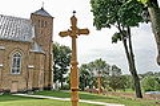
Churchyard
Encyclopedia

Parish
A parish is a territorial unit historically under the pastoral care and clerical jurisdiction of one parish priest, who might be assisted in his pastoral duties by a curate or curates - also priests but not the parish priest - from a more or less central parish church with its associated organization...
itself. In the Scots language
Scots language
Scots is the Germanic language variety spoken in Lowland Scotland and parts of Ulster . It is sometimes called Lowland Scots to distinguish it from Scottish Gaelic, the Celtic language variety spoken in most of the western Highlands and in the Hebrides.Since there are no universally accepted...
or Northern English language
English language
English is a West Germanic language that arose in the Anglo-Saxon kingdoms of England and spread into what was to become south-east Scotland under the influence of the Anglian medieval kingdom of Northumbria...
this can also be known as a kirkyard or kirkyaird.
In England, the fact that in an open field village there were very few fenced areas meant that the yew trees
Taxus
Taxus is a genus of yews, small coniferous trees or shrubs in the yew family Taxaceae. They are relatively slow-growing and can be very long-lived, and reach heights of 1-40 m, with trunk diameters of up to 4 m...
needed for longbows were commonly grown in the churchyard since the foliage is poisonous to cattle.
Churchyards can be host to unique and ancient habitats because they may remain significantly unchanged for hundreds of years.
A churchyard should not be confused with a graveyard
Graveyard
A graveyard is any place set aside for long-term burial of the dead, with or without monuments such as headstones...
or a cemetery
Cemetery
A cemetery is a place in which dead bodies and cremated remains are buried. The term "cemetery" implies that the land is specifically designated as a burying ground. Cemeteries in the Western world are where the final ceremonies of death are observed...
. While churchyards were historically often used as graveyards, they can also be any patch of land on church grounds, even without a place of burial.
Use of churchyards as a place of burial
Historically the most common use of churchyards was as a consecratedConsecration
Consecration is the solemn dedication to a special purpose or service, usually religious. The word "consecration" literally means "to associate with the sacred". Persons, places, or things can be consecrated, and the term is used in various ways by different groups...
burial
Burial
Burial is the act of placing a person or object into the ground. This is accomplished by excavating a pit or trench, placing an object in it, and covering it over.-History:...
ground known as a graveyard
Graveyard
A graveyard is any place set aside for long-term burial of the dead, with or without monuments such as headstones...
. Graveyards were usually established at the same time as the building of the relevant place of worship (which can date back to the 6th to 14th centuries) and were often used by those families who could not afford to be buried inside or beneath the place of worship itself. Most headstones and other memorials are of the 17th century at the earliest, as ground would often be reused for further burials and only some families could afford any memorials.
The use of churchyards as burial grounds for the deceased was discontinued all over Europe in various stages between the 18th to 19th centuries due to lack of space for new headstone
Headstone
A headstone, tombstone, or gravestone is a marker, usually stone, that is placed over a grave. In most cases they have the deceased's name, date of birth, and date of death inscribed on them, along with a personal message, or prayer.- Use :...
s. In many European states, burial in churchyards was outlawed altogether either by royal decrees or government legislation
Legislation
Legislation is law which has been promulgated by a legislature or other governing body, or the process of making it...
for public hygiene
Hygiene
Hygiene refers to the set of practices perceived by a community to be associated with the preservation of health and healthy living. While in modern medical sciences there is a set of standards of hygiene recommended for different situations, what is considered hygienic or not can vary between...
reasons and portions of churchyards were taken in order for road
Road
A road is a thoroughfare, route, or way on land between two places, which typically has been paved or otherwise improved to allow travel by some conveyance, including a horse, cart, or motor vehicle. Roads consist of one, or sometimes two, roadways each with one or more lanes and also any...
s to be built or expanded. The loss of part (or all) of the churchyard, often led also to the removal and permanent loss of centuries old graves and headstones. In some cases the human remains were exhumed and the gravestones transferred. In other cases, all headstones have been removed, to create a park-like environment, or simply to facilitate the seasonal cutting and removal of grass
Grass
Grasses, or more technically graminoids, are monocotyledonous, usually herbaceous plants with narrow leaves growing from the base. They include the "true grasses", of the Poaceae family, as well as the sedges and the rushes . The true grasses include cereals, bamboo and the grasses of lawns ...
or weed
Weed
A weed in a general sense is a plant that is considered by the user of the term to be a nuisance, and normally applied to unwanted plants in human-controlled settings, especially farm fields and gardens, but also lawns, parks, woods, and other areas. More specifically, the term is often used to...
s.
A very small number of churchyards across the world are still used as graveyards today.

